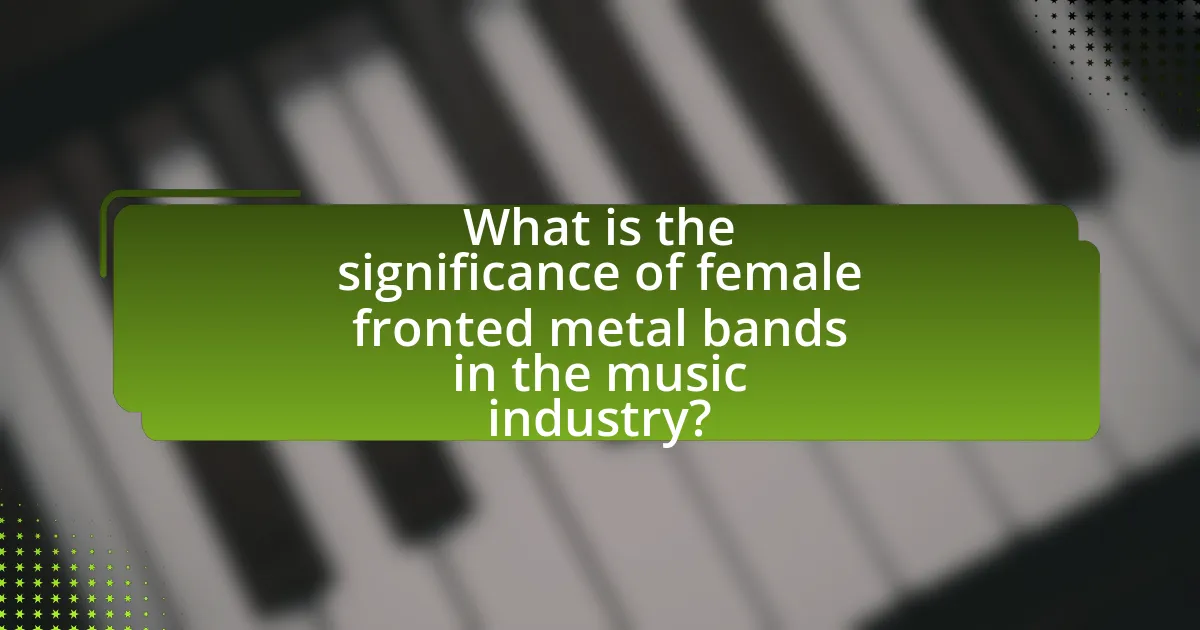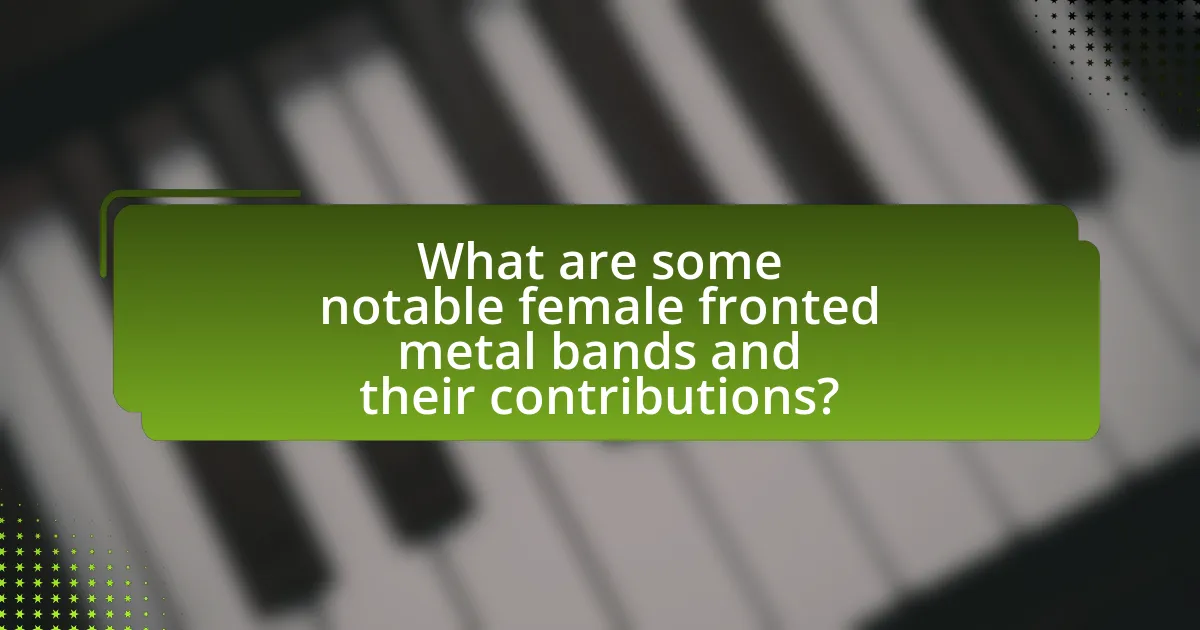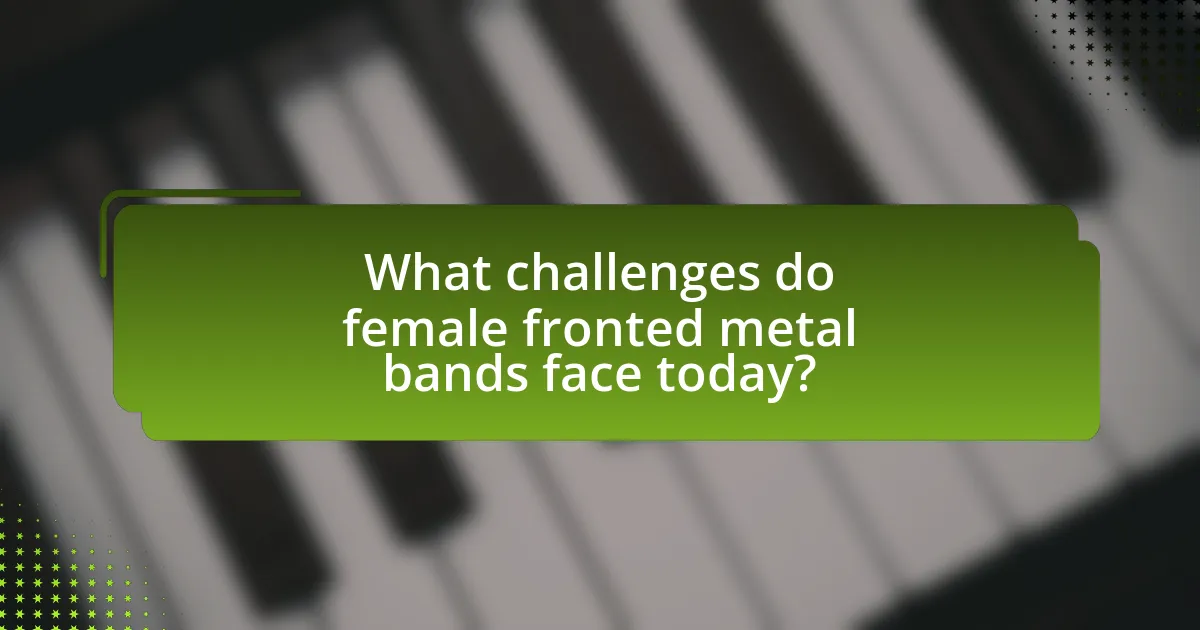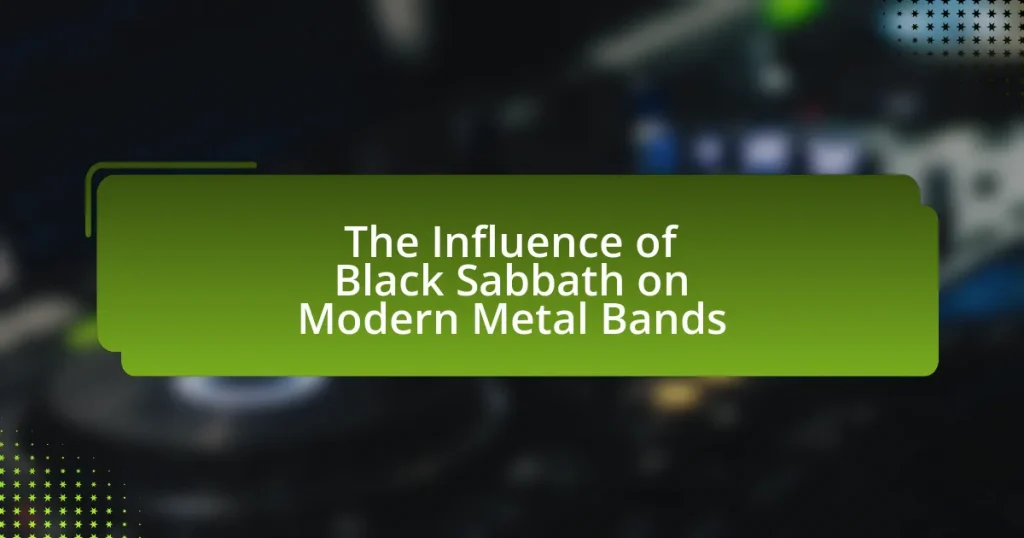Female fronted metal bands have gained significant prominence in the music industry, challenging gender stereotypes and promoting diversity within a traditionally male-dominated genre. This article explores the evolution of these bands, highlighting their historical significance, societal influences, and the impact of representation on the metal community. It discusses notable bands such as Nightwish, Arch Enemy, and Lacuna Coil, their contributions to the genre, and the challenges they face today, including industry biases and limited media representation. Additionally, the article examines the role of festivals in promoting female artists, emerging trends, and how fans can support and uplift female musicians in metal.

What is the significance of female fronted metal bands in the music industry?
Female fronted metal bands are significant in the music industry as they challenge gender stereotypes and promote diversity within a traditionally male-dominated genre. Their presence has led to increased visibility for women in heavy music, inspiring a new generation of female musicians and fans. For instance, bands like Nightwish and Arch Enemy have achieved commercial success and critical acclaim, demonstrating that female-led groups can thrive in metal. This shift has contributed to a broader cultural acceptance of women in various roles within the music industry, from performers to producers, thereby fostering a more inclusive environment.
How have female fronted metal bands evolved over the years?
Female fronted metal bands have evolved significantly over the years, transitioning from niche acts to mainstream recognition. In the early 1990s, bands like Nightwish and Lacuna Coil began to gain traction, showcasing female vocalists in genres traditionally dominated by male musicians. This shift was marked by the blending of operatic and melodic elements with heavy metal, appealing to a broader audience.
By the 2000s, the rise of bands such as Within Temptation and Epica further solidified the presence of women in metal, with their music often addressing themes of empowerment and individuality. The increased visibility of female fronted bands has also led to a diversification of styles, including symphonic metal, metalcore, and gothic metal, reflecting a wider range of influences and artistic expressions.
Statistical data from the 2020s indicates that female fronted bands now comprise a significant portion of festival lineups and album sales, demonstrating their impact on the genre. This evolution highlights not only the changing landscape of metal music but also the growing acceptance and celebration of female artists within the industry.
What historical factors contributed to the rise of female fronted metal bands?
The rise of female fronted metal bands can be attributed to several historical factors, including the feminist movement of the 1970s and 1980s, which challenged gender norms and encouraged women’s participation in traditionally male-dominated genres. This cultural shift allowed artists like Doro Pesch of Warlock and Tarja Turunen of Nightwish to gain prominence, showcasing female vocalists in heavy metal. Additionally, the increasing visibility of women in rock music during the 1990s, exemplified by bands like L7 and Hole, paved the way for female fronted metal acts to emerge and thrive. The evolution of music technology and the internet also facilitated the spread of diverse musical styles, enabling female musicians to reach wider audiences and establish their own identities within the metal genre.
How have societal changes influenced the acceptance of female fronted metal bands?
Societal changes have significantly influenced the acceptance of female fronted metal bands by promoting gender equality and challenging traditional gender roles. The feminist movements of the late 20th and early 21st centuries have led to increased visibility and support for women in various fields, including music. This cultural shift has encouraged audiences to embrace female musicians as legitimate artists rather than viewing them through a narrow lens of stereotypes. For instance, the rise of social media has allowed female fronted bands to reach wider audiences, fostering a community that celebrates diversity in music. Additionally, studies indicate that female representation in metal has grown, with bands like Nightwish and Arch Enemy achieving commercial success, which further normalizes the presence of women in the genre.
Why is representation important in the metal genre?
Representation is important in the metal genre because it fosters diversity and inclusivity, allowing for a broader range of voices and experiences to be heard. This inclusivity not only enriches the music but also challenges stereotypes associated with the genre, which has historically been male-dominated. For instance, the rise of female-fronted metal bands, such as Nightwish and Arch Enemy, has demonstrated that women can excel in heavy music, thereby inspiring a new generation of female musicians and fans. Research indicates that diverse representation in music genres can lead to increased engagement and a more vibrant community, as seen in the growing popularity of female artists in metal festivals and events.
What impact does female representation have on the metal community?
Female representation significantly enhances the metal community by promoting diversity and challenging gender stereotypes. The presence of female musicians in metal not only broadens the genre’s appeal but also encourages more inclusive participation among fans and aspiring artists. Research indicates that female-fronted bands, such as Nightwish and Arch Enemy, have achieved commercial success and critical acclaim, demonstrating that diverse representation can lead to increased visibility and acceptance within the community. Furthermore, studies show that female artists often bring unique perspectives and creativity, enriching the musical landscape and fostering a more welcoming environment for all genders.
How do female fronted bands challenge stereotypes in metal music?
Female fronted bands challenge stereotypes in metal music by redefining traditional gender roles and showcasing diverse vocal styles and stage presences. These bands, such as Nightwish and Arch Enemy, demonstrate that women can excel in genres historically dominated by men, often incorporating powerful and aggressive vocal techniques that defy the notion that only male vocalists can deliver intensity. Additionally, female fronted bands often address themes of empowerment, equality, and personal struggle in their lyrics, further subverting the typical narratives found in metal music. This shift has led to increased visibility and acceptance of women in the metal scene, as evidenced by the growing number of female musicians and fans participating in metal festivals and events.

What are some notable female fronted metal bands and their contributions?
Notable female fronted metal bands include Nightwish, Arch Enemy, and Lacuna Coil, each contributing significantly to the genre. Nightwish, led by Tarja Turunen and later Floor Jansen, is known for pioneering symphonic metal, blending orchestral elements with heavy metal, and has sold over 10 million albums worldwide. Arch Enemy, fronted by Angela Gossow and later Alissa White-Gluz, has been influential in melodic death metal, known for their aggressive sound and empowering lyrics, contributing to the visibility of women in extreme metal. Lacuna Coil, with Cristina Scabbia as a prominent figure, has merged gothic and alternative metal, achieving international success and helping to popularize the genre with hits like “Heaven’s a Lie.” These bands have not only shaped their respective subgenres but have also inspired a new generation of female musicians in metal.
Which bands are considered pioneers in the female fronted metal scene?
Bands considered pioneers in the female fronted metal scene include Nightwish, Lacuna Coil, and Arch Enemy. Nightwish, formed in 1996, is known for integrating symphonic elements with metal and featuring Tarja Turunen as their original vocalist, which set a precedent for female vocalists in the genre. Lacuna Coil, originating from Italy in 1994, blended gothic and alternative metal with dual male and female vocals, influencing many subsequent bands. Arch Enemy, established in 1995, gained prominence with Angela Gossow as their frontwoman, showcasing a powerful female presence in melodic death metal. These bands have significantly shaped the landscape of female fronted metal, inspiring countless artists and contributing to the genre’s evolution.
What unique styles and sounds have these bands introduced?
Female fronted metal bands have introduced unique styles and sounds characterized by a blend of melodic elements with heavy instrumentation. Bands like Nightwish and Within Temptation have pioneered symphonic metal, incorporating orchestral arrangements and operatic vocals, which create a dramatic and expansive sound. Other groups, such as Arch Enemy, have integrated melodic death metal with powerful growls and intricate guitar work, showcasing a fusion of aggression and melody. Additionally, bands like Lacuna Coil have combined gothic influences with alternative metal, resulting in a distinctive atmospheric sound. These innovations have expanded the genre’s diversity and appeal, attracting a broader audience and influencing the evolution of metal music.
How have these bands influenced newer generations of musicians?
Female fronted metal bands have significantly influenced newer generations of musicians by breaking gender stereotypes and expanding the genre’s creative boundaries. Bands like Nightwish and Arch Enemy have demonstrated that women can lead in heavy metal, inspiring countless female musicians to pursue careers in a traditionally male-dominated field. This shift is evidenced by the increasing number of female-led bands emerging in the metal scene, such as Spiritbox and Butcher Babies, which showcase diverse vocal styles and songwriting approaches. Additionally, the success of these bands has led to greater visibility and acceptance of women in various roles within the music industry, from songwriting to production, thereby reshaping the landscape of metal music.
What role do festivals and events play in promoting female fronted metal bands?
Festivals and events play a crucial role in promoting female fronted metal bands by providing them with visibility and opportunities to perform in front of diverse audiences. These platforms often feature lineups that highlight female artists, which helps to challenge gender stereotypes within the metal genre. For instance, festivals like Download Festival and Wacken Open Air have increasingly included female fronted bands, showcasing their talent and expanding their fan base. This visibility not only elevates the profiles of these bands but also encourages industry recognition, leading to more bookings and collaborations. Additionally, events create a sense of community and support among female musicians, fostering networking opportunities that can lead to further career advancements.
How do music festivals showcase female fronted metal bands?
Music festivals showcase female fronted metal bands by featuring them prominently on lineups, providing dedicated stages, and promoting their performances through marketing efforts. For instance, festivals like Download Festival and Wacken Open Air have increasingly included female fronted bands such as Arch Enemy and Nightwish, reflecting a growing recognition of their contributions to the genre. This inclusion not only enhances visibility for these artists but also encourages diversity within the metal community, as evidenced by the rising number of female-led acts gaining popularity and critical acclaim in recent years.
What initiatives exist to support female musicians in metal?
Initiatives that support female musicians in metal include organizations like the Women’s International Music Network (WIMN), which provides resources and networking opportunities specifically for women in the music industry. Additionally, the She Rocks Awards celebrate female musicians and industry professionals, highlighting their contributions to the metal genre. Programs such as Girls Rock Camp empower young girls through music education, fostering future female talent in metal. These initiatives collectively aim to increase visibility, provide mentorship, and create a supportive community for women in the metal scene.

What challenges do female fronted metal bands face today?
Female fronted metal bands face significant challenges today, including gender bias, limited media representation, and difficulties in securing touring opportunities. Gender bias manifests in the form of stereotypes that question the authenticity and capabilities of female musicians, often leading to a lack of respect and recognition in a male-dominated genre. Limited media representation further exacerbates this issue, as female fronted bands often receive less coverage compared to their male counterparts, which can hinder their visibility and growth. Additionally, securing touring opportunities is often more challenging for female fronted bands due to industry biases and the tendency for promoters to favor established male acts, making it harder for these bands to reach wider audiences and achieve commercial success.
How do industry biases affect female fronted metal bands?
Industry biases significantly hinder the visibility and opportunities for female fronted metal bands. These biases manifest in various ways, including limited media coverage, fewer performance opportunities, and a tendency to stereotype female musicians as less capable than their male counterparts. For instance, a study by the University of Southern California found that women in the music industry receive only 22% of all music festival slots, which directly impacts the exposure and growth of female fronted metal bands. Additionally, the perception that metal is a male-dominated genre often leads to a lack of support from industry gatekeepers, further marginalizing these bands.
What barriers do female musicians encounter in the metal scene?
Female musicians in the metal scene encounter several barriers, including gender discrimination, lack of representation, and challenges in gaining acceptance from male-dominated audiences. Gender discrimination manifests in the form of stereotypes that question their musical abilities and authenticity, often leading to a lack of support from industry professionals. The underrepresentation of women in metal creates an environment where female musicians struggle to find role models and mentors, which can hinder their career development. Additionally, female musicians often face hostility or skepticism from male audiences, which can discourage their participation and limit their opportunities for performance and collaboration. Studies have shown that women in music genres like metal frequently report experiences of sexism and harassment, further complicating their journey in the industry.
How can these challenges be addressed within the industry?
To address the challenges faced by female fronted metal bands within the industry, implementing mentorship programs and increasing representation in decision-making roles are essential strategies. Mentorship programs can provide guidance and support to emerging female artists, helping them navigate the complexities of the music industry, as evidenced by initiatives like the Women in Music organization, which has successfully fostered connections and opportunities for women in the field. Additionally, increasing female representation in executive positions within record labels and management can lead to more equitable opportunities and visibility for female fronted bands, as studies show that diverse leadership teams make better decisions and drive innovation.
What strategies can female fronted metal bands use to succeed?
Female fronted metal bands can succeed by leveraging strong branding, engaging with their audience through social media, and collaborating with other artists. Strong branding helps establish a unique identity that resonates with fans, while active social media engagement fosters a loyal community and increases visibility. Collaborations with other musicians can expand their reach and introduce them to new audiences. For instance, bands like Arch Enemy and Nightwish have successfully utilized these strategies, resulting in increased popularity and recognition within the metal genre.
How can social media be leveraged for promotion and engagement?
Social media can be leveraged for promotion and engagement by creating targeted content that resonates with specific audiences, utilizing platforms like Instagram, Facebook, and Twitter to share updates, music releases, and behind-the-scenes insights. For instance, female fronted metal bands can engage fans through live Q&A sessions, interactive polls, and exclusive content, fostering a sense of community and loyalty. According to a 2021 study by the Pew Research Center, 69% of adults in the U.S. use social media, highlighting its effectiveness as a promotional tool. Engaging with fans through comments and direct messages further enhances interaction, making social media a vital component in building a dedicated fanbase.
What role does networking play in the success of female fronted bands?
Networking is crucial for the success of female fronted bands as it facilitates connections with industry professionals, fans, and other musicians. These connections can lead to opportunities for collaborations, performances, and exposure in a competitive music landscape. For instance, a study by the University of Southern California found that artists with strong networking skills are more likely to secure gigs and media coverage, which is essential for building a fanbase. Additionally, networking helps female fronted bands navigate challenges specific to their gender in a male-dominated industry, allowing them to share resources and support each other.
What are the future trends for female fronted metal bands?
Future trends for female fronted metal bands indicate a significant increase in visibility and diversity within the genre. The rise of social media platforms has enabled female musicians to reach wider audiences, leading to a growing fan base and more opportunities for collaboration. Additionally, festivals and events are increasingly featuring female fronted acts, reflecting a shift in industry support. According to a 2021 report by the International Federation of the Phonographic Industry, female artists accounted for 40% of new music releases, highlighting their expanding role in the music industry. This trend suggests that female fronted metal bands will continue to gain prominence, influencing the genre’s evolution and encouraging more women to enter the metal scene.
How is the landscape of female fronted metal expected to change?
The landscape of female fronted metal is expected to evolve significantly as more women take on prominent roles in the genre, leading to increased diversity in musical styles and themes. This shift is evidenced by the growing number of female-led bands and artists, such as Nightwish, Arch Enemy, and Within Temptation, who have gained substantial followings and critical acclaim. Additionally, industry initiatives aimed at promoting gender equality in music are likely to further support this trend, as seen in festivals that prioritize female representation and mentorship programs for aspiring female musicians. As a result, the genre is anticipated to become more inclusive, with a broader range of voices and perspectives contributing to its development.
What emerging artists should we watch in the coming years?
Emerging artists to watch in the coming years include Spiritbox, a Canadian metal band known for their innovative sound and powerful vocals from frontwoman Courtney LaPlante. Another notable artist is Jinjer, a Ukrainian band that has gained international acclaim for their unique blend of metalcore and progressive elements, led by vocalist Tatiana Shmaylyuk. Additionally, the band Butcher Babies, fronted by Carla Harvey and Heidi Shepherd, continues to push boundaries in the metal scene with their energetic performances and strong lyrical themes. These artists exemplify the rise of female-fronted metal bands, showcasing talent and creativity that resonate with audiences globally.
What can fans do to support female fronted metal bands?
Fans can support female fronted metal bands by actively attending their concerts and purchasing merchandise. Attending live shows increases visibility and revenue for these bands, while buying merchandise directly contributes to their financial stability. Additionally, fans can promote these bands on social media platforms, helping to expand their reach and audience. Engaging with their content, sharing posts, and leaving positive reviews can significantly enhance their online presence. Supporting female fronted metal bands in these ways fosters a more inclusive music scene and encourages the growth of diverse talent within the genre.
How can listeners promote inclusivity within the metal community?
Listeners can promote inclusivity within the metal community by actively supporting female-fronted bands and advocating for diverse representation in music. By attending concerts, purchasing merchandise, and sharing music from these bands on social media, listeners can help elevate their visibility and encourage venues to book a wider range of artists. Research indicates that diverse representation in music not only enriches the genre but also attracts a broader audience, fostering a more inclusive environment. For example, a study by the Annenberg Inclusion Initiative found that female artists are significantly underrepresented in popular music, highlighting the need for listeners to champion equality and diversity in the metal scene.
What actions can fans take to uplift female musicians in metal?
Fans can uplift female musicians in metal by actively supporting their music through purchasing albums, attending concerts, and promoting their work on social media. Engaging with female artists’ content increases visibility and helps combat the gender disparity in the metal genre, where women are often underrepresented. For instance, a study by the Annenberg Inclusion Initiative found that only 22.5% of artists in popular music were women, highlighting the need for increased support. By sharing their music, creating playlists that feature female musicians, and advocating for their inclusion in festivals and events, fans can contribute to a more equitable music scene.


